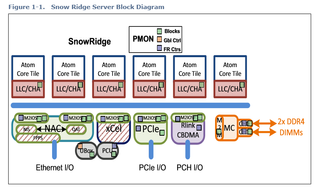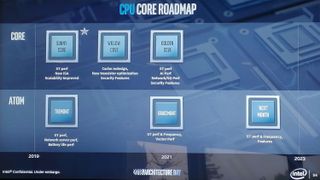Intel’s 10nm Snow Ridge Wields Tremont Atom Cores and Mesh Architecture
Intel’s forthcoming 10nm Snow Ridge SoC for 5G base stations is based on its Atom architecture and also features a mesh architecture. The details stem from an Intel ‘Uncore Performance Monitoring’ reference manual from April but came to our attention via Intel platform engineer Mark Ermolov's recent tweet.
The manual contains a Snow Ridge block diagram and some further pieces of information throughout. The diagram shows six Atom tiles, each with its own last level cache (LLC). Given that this is a 10nm SoC, it is likely based on the new Tremont Atom architecture that is also found in Lakefield. In terms of connectivity, there is Ethernet, support for dual-channel DDR4 through the integrated memory controller (IMC) with ECC support, and PCIe Gen 3.

As a last piece of information, Snow Ridge is based on a mesh architecture (deep dive here), instead of the traditional ring bus. Intel introduced the mesh architecture with Knights Landing in 2016, as part of the Atom-based Xeon Phi series, and with Skylake-SP in 2017 for Xeon. A mesh architecture is analog to a grid street plan, with traffic being routable along any path on the mesh in principle. Intel introduced it because the ring bus was not scalable to high core counts.
This could suggest that Snow Ridge will feature a sizeable amount of cores. However, the block diagram showed only six tiles. In Xeon Phi, a single tile was compromised of two Atom cores. If this holds true for Snow Ridge, then this would imply a core count of 12. It's possible that Intel expanded the Tremont tiles to have four cores, or maybe this diagram does not represent the full amount of tiles, as a note below it says: “This diagram represents one possible configuration. The number of supported cores and LLC slices vary by SKU. Not all features supported on all SKUs.”

What is Snow Ridge?
First shown at its December 2018 Architecture Day and officially announced at CES, Snow Ridge is a product for 5G wireless access and edge computing, or more specifically, intended to get Intel into the market of wireless access base stations. Intel currently has a ~20% market share in networking infrastructure chips, but forecasts that it will reach 40% by 2022 as network operators move from ASICs to software defined networking on standard Xeons, and likely with some help from Snow Ridge.
When Intel showed the at the time unnamed SoC at Architecture Day as a whole new line of server-class processors, the bullet points gave as information that it could handle 100Gbps of traffic and decode multiple H.256 video streams simultaneously, all while having minimal CPU load while data and decode are in progress. In other words, it has H.256 and 100Gbps offload capabilities.

At the time of the announcement, Intel said that Snow Ridge would be available in the second half of this year, but in its July earnings call with investors, that forecast was updated to be in production in the first quarter of 2020.
Stay on the Cutting Edge
Join the experts who read Tom's Hardware for the inside track on enthusiast PC tech news — and have for over 25 years. We'll send breaking news and in-depth reviews of CPUs, GPUs, AI, maker hardware and more straight to your inbox.
-
bit_user Replyit could handle 100Gbps of traffic and decode multiple H.256 video streams simultaneously
Why would base stations need H.265 video decode? Or, is this just aimed at some other application? -
bit_user Reply
They're not doing that in basestations - that's in their actual datacenters.JayNor said:google Stadia?
Most Popular






